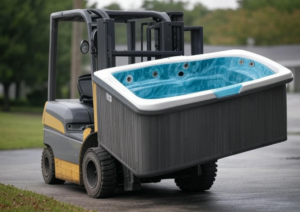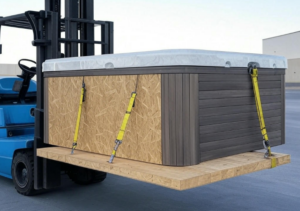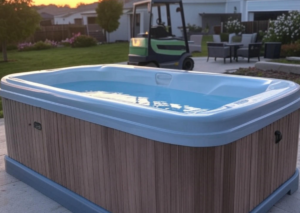Can You Lift a Hot Tub With a Forklift? Your Expert Guide to Safe Lifting
Moving a hot tub may seem simple, but lifting it with a forklift is not as easy as it looks. Forklifts can lift heavy loads, but hot tubs are bulky, fragile, and often awkwardly shaped. In this guide, you will learn what to consider when using a forklift to move a hot tub, the steps to do it safely, and why you may want to choose other methods. We will also compare options, review key factors, and offer troubleshooting tips. By the end of this post, you will have a clear roadmap to decide if using a forklift is right for your situation and how to do it safely.
In the sections that follow, you will read about the basics of hot tub weight, structure, and balance. You will learn about the risks involved and the equipment you need to protect your hot tub. We explain how the ground surface, the forklift’s power, and the operator’s skill all play a role in a safe lift. We also compare forklifts to other methods such as cranes or specialized movers. Each section is written in simple language, with clear steps and visual aids to help you follow along.
Our thesis is simple: Yes, a forklift can lift a hot tub—but only if you plan carefully, use the right gear, and follow all safety steps. You will discover the key points to check before you start, how to set up the lift, and what to do if problems arise. We include tables, charts, and expert tips that break down the process into easy steps. Even if you have little experience, this guide will show you what to look for and how to avoid common mistakes.
Let’s dive into the details and learn how to keep your hot tub and property safe when using a forklift. Your safety and the health of your hot tub depend on careful planning and proper execution. Ready to get started? Read on to learn everything you need to know,

Main Topic Exploration
When you consider lifting a hot tub with a forklift, you must understand its weight, size, and design. Hot tubs are not like boxes or pallets. They have curved shapes and delicate parts. Most empty hot tubs weigh between 500 and 1,000 pounds. When filled with water, the weight can climb to thousands of pounds. Therefore, you should always lift a hot tub when it is empty or only partly drained.
Key Points to Know
-
Forklift Capacity:
Forklifts are built to lift heavy loads. Most standard forklifts can lift 3,000–5,000 pounds. This means an empty hot tub can be lifted safely if the forklift is used correctly. However, the load must be well balanced.“Using the proper equipment and planning is key to any lifting task.”
– Industrial Safety Expert -
Hot Tub Structure:
Hot tubs are usually made of acrylic or fiberglass. Their design may include a curved bottom and internal piping. The parts that make up a hot tub are not built to handle pressure from a forklift’s tines. To avoid damage, you must add a layer of protection between the forks and the hot tub. -
Weight Distribution and Balance:
Hot tubs have an uneven weight distribution. This makes lifting tricky. If the weight is not balanced, the forklift may tip or the hot tub might shift during the lift. This can cause damage or even injury. Simple tools like plywood boards or custom attachments can help distribute the load evenly. -
Safety and Site Conditions:
The ground must be flat and stable. Forklifts work best on hard, even surfaces. If you work on soft or uneven ground, there is a higher risk of accidents. Also, be aware of weather conditions such as wind, which can affect stability. -
Equipment and Attachments:
Standard forklift forks may not work well with hot tubs. Often, you need fork extensions, pallets, or protective boards. These additions protect the hot tub’s shell and help to support the weight more evenly. -
Professional Assistance:
If you are not an experienced forklift operator or if the hot tub is large, hiring professionals might be the best choice. Professionals have the right attachments and training to lift a hot tub without damage.
Detailed Explanation
Imagine a hot tub as a fragile, curved bowl. The forklift must lift it evenly. This is not like lifting a box with flat sides. You must plan the lift, know the hot tub’s weight, and ensure that the forklift has extra support. The added materials—such as a sturdy pallet or plywood—act like a bed for the hot tub, giving a flat and safe surface for the forks.
When you lift the hot tub, start by sliding in the protective board under its base. Next, position the forklift so that the forks align with the strong parts of the hot tub’s frame. This careful positioning prevents damage to the shell and internal components. Always lift slowly, keeping the hot tub low to reduce any risk of tipping. Each step must be planned and executed with care.
In our next sections, we will compare methods, examine factors that affect performance, and give you a step-by-step guide to perform the lift safely.

Comparative Analysis
When moving a hot tub, you have several options. Below, we compare using a forklift with other methods like cranes or professional movers.
Method Comparison Table
| Method | Cost | Safety | Ease of Use | Best Use |
|---|---|---|---|---|
| Forklift | Moderate | High if done correctly | Requires skill | Flat, open areas |
| Cranes | High | Very high | Professional required | Lifting over obstacles |
| Professional Movers | Moderate-High | Very high | Hassle-free | Complex moves |
Equipment Options Table
| Equipment | Function | Pros | Cons |
|---|---|---|---|
| Fork Extensions | Extend fork reach | Better load support | Extra setup needed |
| Plywood Boards | Protect hot tub surface | Distributes weight evenly | May need multiple boards |
| Straps & Slings | Secure load | Enhances stability | Must be rated for the weight |
Both tables give you a quick view of your options. Each method and equipment choice has its pros and cons. When choosing, balance cost, safety, and ease of use.
Performance Factors
Several factors affect how well a forklift can lift a hot tub. Below is an HTML diagram that shows these factors and how they interact:
Key Performance Factors
- Forklift Capacity: Must exceed the weight of the hot tub.
- Weight Distribution: Use supports to balance the load.
- Surface Conditions: Flat and stable ground is required.
- Operator Skill: Experience reduces the risk of accidents.
- Protective Equipment: Use boards, straps, and extensions to protect the tub.
Each factor is key to a safe lift. A forklift with a high capacity is useless if the load is not balanced. Always check that your site is flat and that the operator is experienced.
Implementation Guide
Follow these step-by-step instructions for a safe lift:
-
Pre-Lift Checks:
- Empty the Hot Tub: Drain all water and dry the tub.
- Inspect the Hot Tub: Check for cracks or weak spots.
- Gather Equipment: Collect plywood boards, fork extensions, straps, and any other protective gear.
-
Prepare the Forklift:
- Check Capacity: Make sure the forklift can handle the hot tub’s weight.
- Attach Extensions: Add fork extensions if needed.
- Inspect Forks: Ensure they are in good condition.
-
Set Up the Lift:
- Place Protective Boards: Lay a thick plywood board under the hot tub’s base.
- Position Forks: Slide the forks carefully under the board. Align them with the strongest parts of the tub.
- Secure the Load: Use heavy-duty straps to hold the hot tub in place. Double-check that the load is balanced.
-
Lifting Procedure:
- Lift Slowly: Raise the hot tub only a few inches off the ground.
- Pause for Stability: Stop and check the balance before moving.
- Keep the Load Low: During transport, keep the hot tub close to the ground to reduce tipping risk.
-
Moving the Hot Tub:
- Drive Carefully: Move slowly and avoid sharp turns.
- Use Spotters: Have at least one helper guide you.
- Watch the Terrain: Ensure the ground stays level and clear of obstacles.
-
Lowering and Final Placement:
- Set Down Gently: Lower the hot tub slowly onto a flat, stable surface.
- Remove Equipment: Once the hot tub is secure, remove straps and protective boards.
- Inspect for Damage: Check the hot tub and surrounding area for any issues.
“Safety is not a choice but a responsibility when handling heavy loads.”
– Forklift Safety Authority
Follow these steps carefully. Each step is a safeguard to protect both the hot tub and the people involved. Always stop if you feel something is wrong and re-check your setup before continuing.

Troubleshooting Section
Even with careful planning, problems can occur. Here are some common issues and how to solve them:
-
Unbalanced Load:
- Cause: The hot tub is not centered on the forks.
- Solution: Stop immediately. Lower the hot tub and reposition the forks. Use additional boards or straps to balance the load.
-
Forklift Instability:
- Cause: Uneven ground or overloaded forklift.
- Solution: Ensure you work on flat, hard surfaces. Check the forklift’s capacity and avoid sudden moves.
-
Damage to Hot Tub Surface:
- Cause: Direct contact of forks with the tub’s shell.
- Solution: Always use protective materials such as plywood boards between the forks and the hot tub.
-
Slipping Straps or Slings:
- Cause: Poorly secured straps.
- Solution: Double-check all straps. Use high-quality, rated equipment and retie if needed.
-
Unexpected Movements:
- Cause: Wind or operator error.
- Solution: Wait for calmer conditions and ensure the operator maintains a slow, steady pace.
A simple checklist to resolve these issues is:
- Stop the lift.
- Reassess the balance.
- Re-secure the load.
- Restart only when sure the setup is stable.
By following these troubleshooting tips, you can solve problems quickly and keep the lift safe. Always listen to your team and re-check every step if you feel any uncertainty.
Innovation and Extended Applications
While forklifts are common for lifting hot tubs, new ideas are emerging. Some movers are using custom attachments that shape the load like a cradle. This design helps protect the tub and spreads the weight evenly. Here are some innovative thoughts:
-
Custom Lifting Cradles:
Special frames can cradle a hot tub without using traditional forks. This lowers the risk of damage and helps balance the load better. -
Hydraulic Lifting Platforms:
Portable hydraulic lifts offer a gentle way to raise a hot tub. They can be adjusted to fit the hot tub’s shape and are ideal for small spaces. -
Multi-Purpose Movers:
Some companies now offer movers who work with forklifts, cranes, and even dollies. This flexibility lets you choose the best method for your site. -
Remote-Controlled Lifting:
Advanced forklifts with remote control features can improve safety. The operator can work from a distance, reducing personal risk.
These innovations show that the field is moving toward safer, more versatile lifting methods. They also hint at a future where moving heavy, bulky items like hot tubs becomes easier and less risky.
Long-term Considerations
When planning your lift, think long term. Safety measures and proper equipment are investments. Here are some long-term points:
-
Maintenance:
Regularly inspect all equipment—forklifts, boards, straps—to ensure they remain safe to use. This prevents future mishaps. -
Sustainability:
Using professional equipment and methods may cost more at first, but it saves money by avoiding damage. It also reduces waste from broken hot tubs. -
Upgrades:
As technology improves, new tools and attachments may become available. Stay informed about safer, more efficient lifting methods.
A cost-benefit analysis can show that spending a bit more for safety now can avoid expensive repairs later. -
Legal and Insurance Issues:
Use certified equipment and trained operators. This not only protects you but may also help with insurance claims if problems occur.
Planning with these long-term factors in mind will protect your investment and ensure safe moving practices for years to come.
Expert FAQ Section
Q1: Can any forklift lift a hot tub?
A1: Not every forklift is suitable. You must check that its capacity exceeds the hot tub’s weight and that its forks can be safely adapted.
Q2: What protective measures should I use?
A2: Use plywood boards, fork extensions, and heavy-duty straps. These help distribute the load and protect the hot tub’s surface.
Q3: Is it safe to lift a hot tub on uneven ground?
A3: No. Lifting on uneven ground can cause instability. Work on flat, stable surfaces to reduce the risk of tipping.
Q4: What is the biggest risk when lifting a hot tub?
A4: The biggest risk is an unbalanced lift. If the hot tub is not centered or the weight is unevenly distributed, it may tip or slip.
Q5: How much does it cost to rent a forklift for this job?
A5: Costs vary, but renting an all-terrain forklift can cost around $250 or more. Prices depend on your location and equipment needs.
Q6: Should I hire professionals instead?
A6: For many, hiring professionals is the safest choice. They have the right tools and experience to handle the lift without damage.
Q7: What should I do if something goes wrong during the lift?
A7: Stop immediately. Lower the hot tub, reassess your setup, and fix any issues before trying again.
Conclusion
Lifting a hot tub with a forklift is possible, but it is not a simple task. You must plan every detail, check the equipment, and follow strict safety rules. Our guide has shown you the key factors: proper load balancing, protective materials, and careful site preparation. With the right tools and trained professionals, a forklift can safely lift an empty hot tub. However, for many, using professional movers or cranes is a better choice.
Remember the importance of safety. Always take the time to review each step and check your work. With careful planning and proper equipment, you can avoid damage and injury. If you are unsure, consult experts before proceeding. Your safety and the integrity of your hot tub should be your top priority.
Take the next step today: plan your move with care, invest in the right equipment, or reach out to a professional moving service. Your well-planned lift is the key to a smooth move and lasting results.
Additional Resources
- Forklift Safety Institute: www.forkliftsafety.org
- Occupational Safety and Health Administration (OSHA): www.osha.gov
- Hot Tub & Spa Forums: Engage with community experts on safe moving techniques.
- Professional Moving Services: Local service directories for specialized hot tub movers.
Technical Glossary
- Attachment: An add-on tool for a forklift that helps secure or lift unusual loads.
- Balance: The even distribution of weight to prevent tipping.
- Fork Extensions: Additional parts used to lengthen the forklift forks.
- Hydraulics: The system in a forklift that uses fluid to lift heavy objects.
- Load Capacity: The maximum weight a forklift can safely lift.
- Load Distribution: How weight is spread over a support to maintain balance.
- Operator: The person trained to control a forklift.
- Preventive Maintenance: Regular checks and fixes to keep equipment safe.
- Protective Material: Items like plywood or pads used to guard delicate surfaces.
- Stability: The state of being steady and balanced during lifting.
We hope this guide helps you make an informed decision about lifting a hot tub with a forklift. Feel free to ask for more details or further explanations as you plan your next move. Your safety is our priority!
